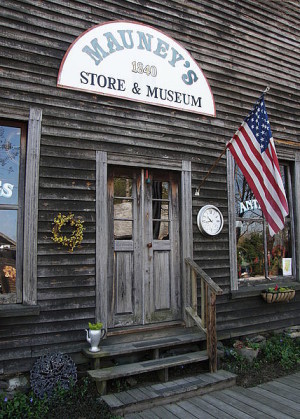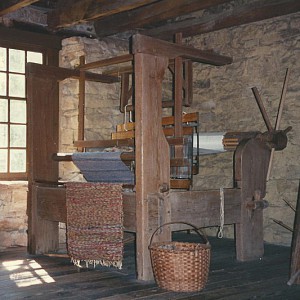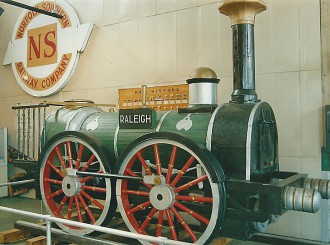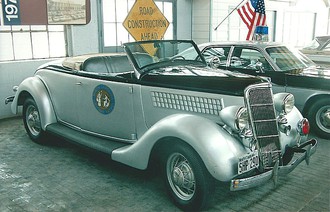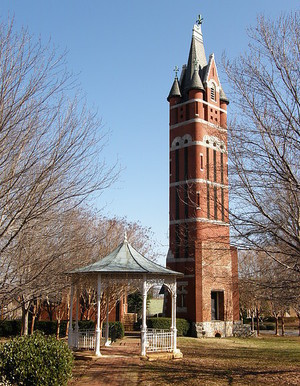ROWAN COUNTY
Scroll down this page or click on specific site name to view the features the following Rowan County attractions/points of interest:
Dan Nicholas Park, Historic Gold Hill, Josephus Hall House, Kerr Mill at Sloan Park, Lazy 5 Ranch, Meroney Theater, Michael Braun House, North Carolina Transportation Museum, Rowan Museum, Salisbury Heritage Walking Tour, Tiger World, Utzman-Chambers House
Fast facts about Rowan County:
Created in 1753, he county is named for Matthew Rowan, acting governor of colonial North Carolina at the time the county was formed.
The county seat is Salisbury, named after the town of Salisbury, England. Other communities include China Grove, East Spencer, Faith, Mount Ulla, Spencer, and part of Kannapolis.
Rowan County’s land area is 511.31 square miles; the population in the 2010 census was 138,428.
It is worth noting that the North Carolina Transportation Museum, a state historic site, is located in Spencer.
Below: Confederate memorial in downtown Salisbury
Southeast of Salisbury
For family-oriented outdoor recreation, it’s hard to find anything better than Dan Nicholas Park, located eight miles southeast of Salisbury. The focal point of the 425-acre park is the 10-acre lake, and paddleboats are available for rent. The old-fashioned Haden’s Carousel puts smiles on the faces of kids and parents alike, as does the 1950s-era miniature train. In addition to these attractions, the park features a nature center, petting barn, "splash pad," and gem mine. If still more activities are needed, the park offers camping, fishing, walking trails, and picnic facilities, as well as tennis courts, four ball fields, and two miniature golf courses. Dan Nicholas Park is located at 6800 Bringle Ferry Road. Hours are dawn to dusk daily. Admission is free; nominal charge for train and carousel rides, petting barn, and wildlife adventure. 704-636-2089
Gold Hill
Located about fifteen miles southeast of Salisbury off US 52, the historic Village of Gold Hill has a small grouping of shops in restored 19th century buildings, an ice cream parlor, sites of interest associated with the gold mining industry which made it a thriving “boom town” in the mid-1800s, and a small park and playground for quality family time. The precious metal which gave Gold Hill its name was first discovered in this vicinity in 1824. Until the discovery of gold in California in 1849, North Carolina was the leading gold-producing state in the nation, and Mecklenburg, Cabarrus, and Rowan counties were at the heart of the gold-mining industry. By the 1840s, Gold Hill was at the center of what was deemed “the richest mining territory east of the Mississippi,” and no less than 23 of the richest mines in the southeast were located here.
In its hey-day, Gold Hill rivaled Charlotte in population and was a town of social and economic importance. Along with nearly two dozen saloons to quench the thirst of about 3,000 miners, the town also boasted some of the finest private homes in the state, belonging to mining engineers and mine owners. It takes approximately one hour to visit the major sites and landmarks along the historic trail. On the way you’ll see an authentic Chilean Ore Mill, a primitive tool used to pulverize gold-laden ore; the powder house, dug into the side of a hill and used to store dynamite and other blasting supplies; the ruins of the stamp mill; and the original assay office. Many of the Gold Hill miners were from Cornwall, England, and displayed in front of the assay office is a Cornish kibble. The dirt and gravel trail will also take you by the Randolph Shaft, in its day one of the richest mining operations in the state.
About a half-dozen buildings line the major thoroughfare through town, most of which are now occupied by shops. The oldest is Mauney’s, built in 1840. It first served as a general store, then a feed store, and finally a grist mill. In the aftermath of Hurricane Hugo, the dilapidated structure came dangerously close to being taken down. Instead, concerned area residents came together and Mauney’s, along with several other village buildings, were restored and given new life. Today, a little more than 70 acres constitute the revitalized historic district. Mauney’s now sells antiques, and displays dozens of photographs, maps, and artifacts relating to Gold Hill’s early years. Across the street is E. H. Mont-gomery’s General Store and Pickin’ Parlor, serving ice cream, soda, and snacks up front, shooting “olde tyme” photographs in the backroom saloon, and hosting live blue grass music most Friday nights all year round. Katie’s Amish Heirlooms occupies the old filling station, a florist and gift shop is found in the former post office, and two log cabins are filled with gardening accessories. Most shops are open Thursday-Sunday from 11-4; individual shop hours may vary. Special events are held periodically, including “ghost walks,” an antique motorcycle show, and cycling and hiking events. The playground is open until dark. For those interested in getting a more detailed tour, call 704-267-9439 or 704-960-6457 for more information.
Salisbury
Not every historic home has artillery adorning its front lawn. In the case of the Josephus Hall House in Salisbury, however, such an unusual lawn ornament seems highly appropriate. The cannon in question once guarded Salisbury’s Confederate prison, and, as Dr. Hall was chief surgeon for the facility, its placement on the lawn of his home seems very fitting. The Dr. Josephus W. Hall House, operated by the Historic Salisbury Foundation, is a marvelously restored antebellum mansion that was home to several generations of the Hall family. Built in the 1820s, the structure was originally home to the Salisbury Female Academy. In 1859, Dr. Hall purchased the property for a modest $3,500 and quickly set about making changes that dramatically altered the home’s appearance. The well-travelled doctor had lived for a time in the mid-west and had taken a liking to the decorative iron scrollwork used on many homes in that area. Just prior to the outbreak of the Civil War, at a cost of less than $120, he purchased from a company in St. Louis the ornate scrollwork which has since become the home’s most distinctive architectural feature. The gate at the front of the lawn, purchased at the same time, actually took several years to arrive. Misplaced in transit at the start of the war, it found its way to Salisbury only after the war’s conclusion. The striking hipped roof was not added until the 1910s, many years after Dr. Hall’s passing. Interior rooms are very large, with first floor ceilings rising to 12’ and second floor ceilings stretching to 14’. Befitting the size of the rooms, many of the furnishings, especially those in the upstairs bedrooms, are truly massive. Rose medallion china purchased in France and a piano in the formal parlor speak to the family’s affluence.
Several items within the house have connections to United States presidents or to the nation’s capital. One such piece is the handsomely-carved wood desk actually used by the Chief Clerk of the US Senate, removed from the Senate chambers when it underwent restoration dur-ing President Grant’s administration. A game table in the downstairs hallway was among the White House furnishings when Benjamin Harrison resided there. Displayed in the second floor hallway is a desk once owned by Salisbury lawyer Spruce Macay and used by president-to-be Andrew Jackson when he studied law under Macay in the 1780s. Also displayed is the pardon Dr. Hall received from President Andrew Johnson following the “late rebellion.” As a financial contributor to the Confederacy and chief surgeon at the Salisbury prison, the doctor was in need of a special pardon for his participation in the war. The Josephus Hall House is located at the corner of East Bank and South Jackson Streets. Open 1-4 on Saturdays and Sundays only. Admission charged. 704-636-0103
Mount Ulla
Located at Sloan Park, eight miles west of Salisbury off NC 150, the picturesque Kerr Mill is adjacent to a 93-acre natural area offering picnic shelters, playgrounds, a ball field, and areas for volleyball and horseshoes. Near the site of the old Mill Bridge Community, the 1823 mill was the primary source for flour and cornmeal for the western part of Rowan County. Milling equipment and artifacts from the early 1800s are on display. Park hours are dawn to dusk daily. Mill is open 1-7 Saturdays and Sundays. Free admission. 704-637-7776
NC Highway 150 between Salisbury and Mooresville
Over 700 animals from around the world are on view at the Lazy 5 Ranch, a mostly drive-through zoo where you get to feed many of the animals from your car. The 3.5 mile route meanders through 70 acres of rolling pastureland, where species from six continents can be seen: antelopes and ostriches, cows and camels, reindeer and rhinos, and many more. The llamas are especially friendly; the zebras and water buffalo are not. Baby animals are always a treat to feed, and you’ll want to have plenty of film in your camera to capture the moments. For those not wanting to drive their personal cars through the compound, horse drawn wagon rides are available for an additional charge. The Lazy 5 also has petting areas, a picnic area, and a playground. Parents and guardians should be aware of a Ranch rule strictly enforced – no matter how badly children might be behaving, no one is allowed to feed them to the animals! Year-round hours are 9 AM until one hour before sunset Monday through Saturday and 1 PM until one hour before sunset on Sunday. Admission charged [no debit or credit cards accepted]. 704-663-5100
Salisbury
A portrait of Sarah Bernhardt graces the lobby of the historic Meroney Theater for good reason – this icon of the American stage performed here in 1906. Restoration of the quaint theatre, built in 1905, was completed in 1995, and the small auditorium provides a cozy atmosphere in which to enjoy a live performance. The Piedmont Players, one of the oldest community theatre groups in the state, are pleased to offer the opportunity for you to do so. The Players perform several stage shows a year, from comedies and musicals to dramas and children’s shows. 2013 marks the company’s 19th season in the Meroney Theater, and they have performed more than 200 shows on its stage. Their efforts recently earned them recognition “For Sustained Excellence” by the N. C. Theatre Conference. The Meroney Theater is located at 213 South Main Street. 704-633-5471
Granite Quarry
One of the oldest surviving homes in the North Carolina Piedmont is located in Granite Quarry, a few miles east of Salisbury. The Michael Braun house, a handsome two-story rock house completed in 1766, is known locally as the Old Stone House. It is the oldest home in Rowan County and the county’s only surviving structure from North Carolina’s colonial period. Michael Braun (Anglicized “Brown”) emigrated with his parents from Germany in 1737, originally settling in Philadelphia. In 1758, Braun traveled down what was to become known as the Great Wagon Road to the North Carolina backcountry. A wheelwright by trade, he bought land in Rowan County and in time established himself as a large planter. The house he had built for himself and his family took several years to construct, and, when the work was done, the names of Michael and his first wife, Margareta, were carved in stone on the front of the house. Below their names is a line bearing the numbers and letters “10 Pe-Me-Be-Mi-Da 1766.” The letters are thought to be an abbreviation for a Biblical phrase, “My undertaking is completed, thanks be to Christ,” while the numbers refer to the month and year – October, 1766 – when the house was finished. The front of the house is coursed native stone with lined joints; the sides and rear are of uncoursed stone. Despite its sturdy construction, the house had fallen into a severe state of disrepair by the time it was acquired by the Rowan Museum, Incorporated in 1959, whereupon it underwent an extensive six-year restoration.
The home’s first floor exemplifies the simple Quaker floor plan popular in Pennsylvania. Two rooms on the left feature corner fireplaces that share a common chimney; on the right is a spacious “great room” with a narrow, rectangular room at the back. At the extreme right as one faces the house is the attached kitchen. The most striking feature of this room is the massive, eight foot wide fireplace. The second floor is largely unfinished, offering a revealing look at the interior construction. One finished room upstairs served as a bedroom, likely a guest room for travelers when the house was used as a stage coach stop. The house museum showcases many interesting furnishings, including a large German "kas" in the
great room, a rare candle-making “carousel” in the kitchen, and a weaving loom on the second floor that, as far as anyone knows, is original to the house. Also displayed are portraits of King George III and Queen Charlotte, Braun’s original land grant, and a map of North Carolina printed in 1795, one of the first printed in the United States. Additional artifacts include items unearthed during recent excavations under the kitchen, including a 1740s half penny, clay marbles, and a gun lock. The most memorable item might be an antique Bible box with a carved swastika on the lid; until it became the symbol for Hitler’s Third Reich, the swastika was commonly used as a sign of good fortune. Michael Braun was married three times and had twelve children. A family graveyard is located across the road from the house. The Michael Braun House is open for tours 1-4 on Saturdays and Sundays from April through November. Take Exit 76 off I-85. Bear right and go east on US 52 approximately four miles. Arriving in Granite Quarry, take the first left after the stop light (Lyerly Road) and drive ½-mile. Admission charged. To arrange for special tours, contact the Rowan Museum at 704-633-5946.
Spencer
For those who have affection for vintage trains and antique automobiles – and that’s just about all of us – the North Carolina Transportation Museum is a wonderful attraction. Of more than two dozen diverse state historic sites, the Transportation Museum ranks second with respect to visitation, and its popularity is easy to understand. Visitors to the site will find more than enough activities to fill a morning or afternoon, and the Barber Junction train station, built in 1898 and moved to its current site in 1980, helps set the proper mood. The canary-yellow depot serves as the visitor information center, and it is here that visitors can purchase tickets for a round-trip train ride that takes passengers on a 25-minute narrated tour of the 57-acre site. The train runs daily from April 1 through Labor Day and weekends only September through December.
The Museum occupies a portion of the sprawling Spencer Shops complex, a steam locomotive maintenance and repair facility which was built in the last dec-ade of the 19th century at the midway point of Southern Rail-way’s line from Atlanta, GA and Washington, DC. The Shops opened in 1896 and continued to expand during the early decades of the 20th century. As steam engines gradually gave way to diesel locomotives, however, Spencer Shops eventually outlived its usefulness, and the facility was shut down altogether in the 1970s. The site was donated to the state through gifts in 1977 and 1979.
The 37-bay roundhouse, built in 1924, showcases many painstakingly-restored steam locomotives, rail cars, private cars, and cabooses. In the orientation room located in the roundhouse, visitors can see a film about Spencer Shops in its hey-day; in another area of the building is a detailed scale model of the Spencer Shops complex, an exhibit on the daily life of Shop employees, and displays on North Carolina railroads in general. Included among these is a full-sized replica of the Raleigh, the state’s first steam locomotive. Outside the roundhouse, visitors can take a 5-minute “spin” on the 100-foot turntable.
Located in the old Flue Shop is a wonderful collection of antique automobiles. Featured in the “Bumper to Bumper” exhibit are some true classics, among them a fire-engine red 1907 Model R Ford and a 1958 Edsel with its distinctive “horse-collar” chrome grill. Also displayed is a silver-and-black State Police car, the only one left from North Carolina’s original 1936 fleet of convertibles. Appropriate backdrops, vintage advertisements, road signs, and other period memorabilia add to the exhibit’s ambiance. Another exhibit, entitled “Wagons, Wheels, and Wings,” is housed in a part of the Master Mechanics Office and provides a brief history of Tar Heel transportation over the centuries, from dug-out canoes to horse-drawn wagons on plank roads. Temporary and traveling exhibits are also shown in this building.
Currently in the works is a complete overhaul of the massive Back Shop. The length of two football fields and twice as wide, the Back Shop was the area in which major repair work was done on the steam locomotives. The building will become the home of a state-of-the-art exhibit showcasing all manner of transportation – not just trains and cars, but planes, boats, buses, balloons, and any other conveyance that helped moved North Carolina. The Transportation Museum is open 9-5 Monday-Saturday and 1-5 Sunday from April 1 through October 31. Hours are 10-4 Tuesday-Saturday and 1-4 Sunday from November 1 through March 31. Closed New Year’s Day, Veterans Day, Thanksgiving, and Christmas. Admission is free. A small fee is charged for the train rides and turns on the turntable. Amenities include a picnic area, vending area, and gift shop.
Salisbury
Rowan’s third courthouse, built between 1854 and 1857, served the county as intended until 1914, when a larger facility was opened. The old courthouse was soon adapted for use as a Community Building, housing a variety of organizations through most of the 20th century. In 1997, the building was leased to Rowan Museum, Inc. The historic building reopened in October 2001, with its first floor rooms filled with exhibits touching on the cultural, commercial, and military history of the county. One room is dedicated to the Daughters of the American Revolution. Here you’ll learn about the heroic sacrifice tavern keeper Elizabeth Maxwell Steele made during the darkest days of the War of Inde-pendence. As General Nathan-ael Greene and his army passed through Salisbury in January 1781, with Lord Cornwallis and the British army in hot pursuit, Steele aided the cause by giving General Greene her life savings! Rowan Museum is located at 202 North Main Street. Hours are 1-4 Thursday through Sunday. Admission charged. Tours are self-guided. 704-633-5946
Salisbury
The first stop for any visit to Rowan County should be the Visitors Center, located a block east from the heart of downtown Salisbury. The modern and spacious center has brochures available for all the county sites, helpful maps, and information galore about antique stores, specialty shops, restaurants, and accommodations in the area. The center is also the starting point for the Civil War Heritage and African-American Heritage Driving Tours and the Salisbury Heritage Walking Tour. The self-guided walking tour takes visitors through the Downtown and West Square Historic Districts. On the northeast corner of Innes and Main Streets stands the Kluttz Drug Store. At the time of its construction in 1858, this three-story structure was the tallest commercial building in North Carolina! Across the street, fixed to the side of the 7-story Plaza Building -- Salisbury's signature "skyscraper" -- is a plaque informing readers that, in 1765, Salisbury was the starting point for what would eventually become known as the Daniel Boone Trail leading westward into Kentucky.
Other points of interest on the tour include the site of the town well, Salisbury’s oldest landmark, dug in 1760 by an ancestor of Adlai Stevenson; the 1820 law office of U. S. Congressman and N. C. Assemblyman Archibald Henderson; the 1909 Confederate Memorial, honoring Rowan County’s 2,500 soldiers; the 1855 Presbyterian Sessions House; and a 127’ x 48.5’ historical mural by Salisbury native Cynvia Arthur Rankin entitled “Crossroads: Past into Present,” which depicts downtown Salisbury at the turn of the 20th century. Spend time at the Old English Cemetery and you'll find the gravesites of Governor John W. Ellis, in office at the time North Carolina seceded from the Union and joined the Confederacy, and Colonel Charles Fisher, killed at the battle of Bull Run and for whom Fort Fisher was named. The walking tour also passes the distinctive brick Bell Tower, the only remnant of the First Presbyterian Church building that once stood here. The tower was saved from demolition in the 1970s and has become symbolic of preservation efforts throughout the city and county. The Rowan County Convention and Visitors Center is located at 32 East Innes Street. Hours are 9-5 Monday-Friday, 10-4 Saturday, and 1-4 Sunday. 704-638-3100
Rockwell
Committed to the rescue, rehabilitation, and preservation of exotic animals, Tiger World is quite a bit different from the typical zoo. On weekdays, visitors are given a personally-guided tour of the preserve, allowing them opportunities to see the animals up close, eating, sleeping, and playing in natural settings. On weekends, the site is self-guided. The facility places a high emphasis on promoting awareness about endangered species. Although the preserve is home to monkeys, bears, wolves, and lemurs, among other wold animals, as the name Tiger World might suggest, there is a large population of big cats: lions, tigers, jaguars, leopards, lynx, ligers, and bobcats. Purr-fectly delightful! Hours are 9-5 Monday, Tuesday, and Thursday through Sunday. Closed Wednesdays, Thanksgiving Day, and Christmas Day. Admission charged. 704-279-6363
Salisbury
Built for cabinetmaker Lewis Utzman circa 1819, the Utzman-Chambers House is a two-story white frame structure. The interpretation of the Utzman-Chambers House is that of a house museum, with its collection of artifacts encompassing the period 1760-1820. Examples of Hepplewhite, Chippendale, and Duncan Fife furniture, along with many pieces by local 18thcentury cabinetmaker James Gheen, are found throughout the home. A dominant architectural feature of the house is the suspended staircase in the side entrance hall. The house itself is a rare surviving example of a Federal-period townhouse and is listed on the National Register of Historic Places. The Utzman-Chambers House is open weekdays 10-4 and 1-4 Saturday and Sunday. Admission is free; donations are accepted. 704-633-5946
Rowan County is bordered by CABARRUS (Region Seven), DAVIDSON, DAVIE, IREDELL (Region Eight), and STANLY (Region Seven) counties.
Return to REGION SIX HOME PAGE.
Return to GEOGRAPHIC REGIONS HOME PAGE.













